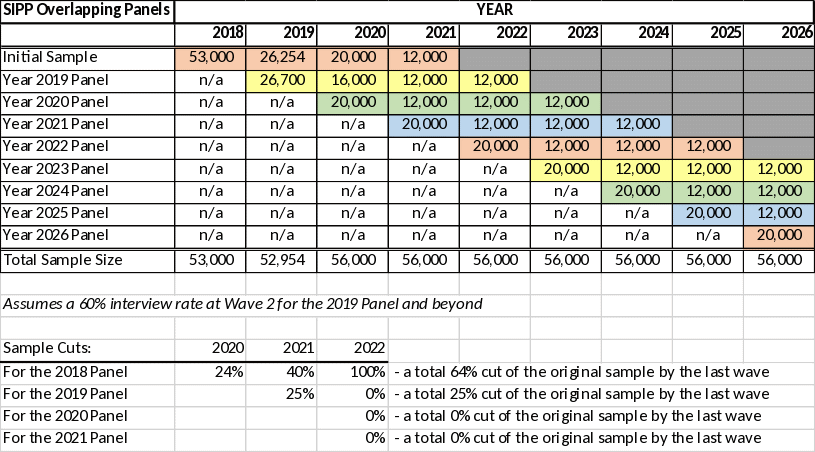Survey of Income and Program Participation
SIPP 2019 OMB Non-Sub Change Request.docx
2018 Survey of Income and Program Participation Panel
Survey of Income and Program Program Participation
OMB: 0607-1000
OMB Non-Substantive Change Request
Department: Commerce
Agency: U.S. Census Bureau
Title: Survey of Income and Program Participation (SIPP)
OMB Control Number: 0607-1000

The U.S. Census Bureau requests a non-substantive change to the currently approved SIPP Information Collection Request. The Census Bureau received a three-year clearance by OMB, which expires on November 30, 2020.
Background
In the SIPP 2018 Panel OMB supporting statements, the Census Bureau presented two possible sampling scenarios. We conducted the Wave 1 collection under the first scenario of selecting a sample of 53,000 cases and following the households over a period of 4 years, with no sample replacement over the life of the Panel. Starting with the 2019 survey year, we propose using a modification of the second sample design scenario of overlapping panels where we supplement sample each year, maintaining the level of interviewed cases in each subsequent year to keep the total pool of interviewed cases constant, mitigating sample loss. This means that there would be a new Wave 1 sample introduced each year. We would interview each independent sample in its entirety over the four to five-month interview period. We would not divide them further into monthly samples, interviewing and closing out each month of the interview period, as previously proposed. All panels interviewed during the same survey year will report information for the same reference period, which is January through December of the previous year.
There is no change to the SIPP respondent universe, the representativeness of the sample, or to creating the multistage stratified sample as described in the OMB Supporting Statement Part B.
SIPP Overlapping Panels Sample Design Justification
Due to the high noninterview rate in the SIPP 2018 Panel, we decided to consider a revised overlapping panels sample design, similar in concept to the design described in the 2018 Panel OMB Package. This will ensure there would be enough data to continue to produce accurate cross-sectional and longitudinal estimates. In the SIPP 2018 Panel, there are 53,000 designated housing units, 45,000 are eligible, and we interviewed 26,000 units (58.5%) in Wave 1. If we assume 25% noninterview for each subsequent wave, we will expect to have 32.8% or less overall interviewed (including the spawn cases) by the end of the panel. This low interview rate will lead to a larger variability on the key estimates, and we may not meet the minimum Census quality standard rules for publications. Additionally, we may face technical issues in the weighting, requiring much more cell collapsing. For these reasons, we concluded that an overlapping panels design would provide better cross-sectional and longitudinal estimates.
The idea of the overlapping panels is to do random sample reductions on the current panel (SIPP 2018) and one on the 2019 Panel to make enough room for starting a new panel of 20,000 each year. Table 1 shows the sample size of each panel by year. It is clear that after year 2020, the sample size will be stable assuming an expected 60% interview rate. The overlapping panel model will provide approximately 33,600 interviewed housing units every year. We think that would give us the best design for both cross-section and longitudinal estimates. We are planning to continue to provide monthly and longitudinal weights; Monthly weights will incorporate all the panels in the field at that time and longitudinal weights will depend on individual panels.
Table 1. SIPP Overlapping Panels Proposed Design by Year

Note: If we need to adjust the sample size to fit within the 53,000 workload per year, we could pull persistent Type A noninterviews from the workloads.
Data Collection
By adapting the overlapping panels design, SIPP would be more like some of the Census Bureau's other panel surveys, such as Consumer Expenditure-Quarterly and the Current Population Survey. In these surveys, field interviewers have a mix of new sample cases and returning sample cases in their workloads. Each independent panel will be drawn from the same geographies, so that staffing needs would be constant in level and location.
Burden
There is no change in respondent burden hours associated with this sampling change.
| File Type | application/vnd.openxmlformats-officedocument.wordprocessingml.document |
| Author | Cindy S Easton (CENSUS/ADDP FED) |
| File Modified | 0000-00-00 |
| File Created | 2021-01-20 |
© 2025 OMB.report | Privacy Policy